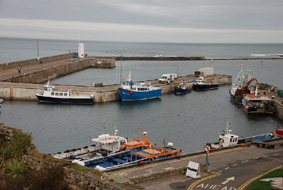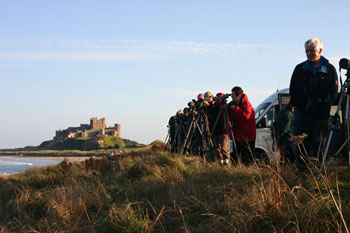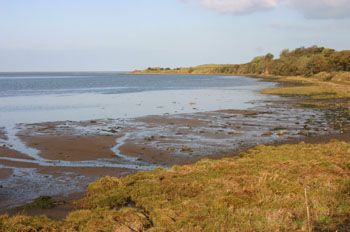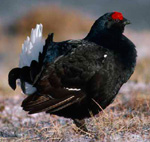TRIP REPORT from Northumberland Coast holiday
October 12th to 14th 2007
Guests in this party were:
Brian & Pam Denton, David Betts, Michael Harbron, Christopher & Mary Ash, Margot Perry, Angela Machersie, Dr David & Anne Nicholas, Roy & Annette Waring, Michael & Sandra Parkin, Christine Roberts, John & Sue Harrison, Philip Dronfield, Noel Harvey, Malcolm & Elaine Sparey, Lawrence Hurst, Peter Cummins, Linda Vickers
REAL BIRDWATCHING
 In October 2007, I joined some friends for a weekend based at Seahouses, just south of Bamburgh Castle, where the fishing boats put out to sea before daybreak and the little harbour is home to a score of Eider duck almost within touching distance.
In October 2007, I joined some friends for a weekend based at Seahouses, just south of Bamburgh Castle, where the fishing boats put out to sea before daybreak and the little harbour is home to a score of Eider duck almost within touching distance.
The whole Area of Outstanding Natural Beauty on the Northumbrian coast was new to me, but not to our two guides, Nick Mason and Tom Cadwallender. Nick, a biologist, was the RSPB's Conservation Officer for the North of England for many years and now runs Real Birder Tours, as well as managing conservation schemes in Cumbria. Tom, a proud Geordie, was secretary to the BTO and a member of its executive for ten years. He wrote “ Birdwatching on the Northumbrian Coast ” as well as the official documentation for the Northumberland Coast AONB – a fount of information on local history, archaeology, birds and flowers, as well as being a leading expert on the Roseate Tern. With their expertise and the additional ingredient of superb autumn weather, the scene was set for two days of memorable birdwatching.
Our first day was spent in Druridge Bay, just south of the dramatic remains of Dunstanburgh Castle – eight miles of pristine sand backed by dunes and restored deep and open cast mining. It is now landscaped into pools, islets, fields and wetlands with low scrub and grasslands behind the dunes, specifically designed to give cover and food to tired incoming migrants. The area comprises no less than five separate nature reserves and the whole AONB is variously designated as a Heritage Coast, Special Protection Area, Special Area of Conservation, Ramsar Site and European Marine Site: quite a special part of the country.
 At our first stop, Hauxley Nature Reserve, we were delighted by a score of Tree Sparrows, some using the nut feeders beside the Reception building and we watched Kingfisher, Greenshank, Curlew, Golden Plover, Snipe, Wigeon and all the usual residents of small lakes, as well as a steady autumn influx of Fieldfares, Redwings and Blackbirds arriving from Scandinavia and refuelling in the sheltered trees and scrub.
At our first stop, Hauxley Nature Reserve, we were delighted by a score of Tree Sparrows, some using the nut feeders beside the Reception building and we watched Kingfisher, Greenshank, Curlew, Golden Plover, Snipe, Wigeon and all the usual residents of small lakes, as well as a steady autumn influx of Fieldfares, Redwings and Blackbirds arriving from Scandinavia and refuelling in the sheltered trees and scrub.
As the day progressed, we worked our way south from one reserve to the next, including the seascape offshore, with good views of Pintail, Common and Velvet Scoter, Long-tailed Duck, Red-breasted Merganser, Goldeneye, Scaup , Pink-footed, Brent and Greylag geese, Little Stint, Curlew Sandpiper, Bar-tailed Godwits, a Red-throated Diver and a very belated juvenile Common Tern.
Day two took us northward to Bamburgh Castle, where the foreshore is composed of low rock and coal seams (the Whin Sill) which extend offshore to form the Farne Islands and then on to Holy Island, returning via Budle Bay. We viewed Purple Sandpiper, Turnstone, Oystercatchers on the rocks, Rock Pipits flitting among them, still more Eider duck, a few late Sandwich Terns, Razorbills, Puffins and Gannets as well as a seal and a porpoise offshore. As we “walked the walk” around Lindesfarne Castle, the Fieldfares, Redwings and incoming Blackbirds continued to arrive and several hundred Shag crowded together on the offshore inlet. On the causeway, when we returned before the tide covered it, there was a glowing carpet of thousands of Golden Plover, together with Dunlin, Knot, Grey and Ringed Plover and half a dozen Barnacle Geese resting on the mud. Overhead, hundreds of pinkfeet called as their arrowhead skeins moved inland.
 We returned via Budle Bay, a well-timed stop with the high tide crowding the birds into the Bay and the sun starting to decline behind us. A peaceful picture – in the foreground hundreds of Shelduck , Mallard, Wigeon and Lapwing and behind them a line of some three thousand Barnacle Geese along the shore. Suddenly the whole scene erupted in wheeling tumbling clouds of Lapwing and gulls, shooting arrows of various duck and a roaring tide of Barnacle Geese, as a Peregrine swept across the Bay. The panic finally subsided and we left a tranquil sunlit picture once more, the brilliant colours of the Shelduck contrasting with the glowing autumn leaves on the trees behind us.
We returned via Budle Bay, a well-timed stop with the high tide crowding the birds into the Bay and the sun starting to decline behind us. A peaceful picture – in the foreground hundreds of Shelduck , Mallard, Wigeon and Lapwing and behind them a line of some three thousand Barnacle Geese along the shore. Suddenly the whole scene erupted in wheeling tumbling clouds of Lapwing and gulls, shooting arrows of various duck and a roaring tide of Barnacle Geese, as a Peregrine swept across the Bay. The panic finally subsided and we left a tranquil sunlit picture once more, the brilliant colours of the Shelduck contrasting with the glowing autumn leaves on the trees behind us.
These were indeed two memorable days, not focusing on “ticks” for exceptional rarities but on all the variety of some ninety plus species moving, feeding and resting in what must be one of the most beautiful parts of Britain. The perfect weather, the variety of habitats and the cheerful, informative and well-planned guidance of our two leaders made for a happy and rewarding experience.
Noel Harvey – October 2007
Bird Species Trip List compiled by Brian & Pam Denton
| Name |
Species |
Day 1 Druridge Bay |
Day 2 Bamburgh and Holy Island |
| Red Throated Diver |
Gavia stellata |
* |
* |
| Great Crested Grebe |
Podiceps cristatus |
* |
* |
| Red Necked Grebe |
Podiceps grisegena |
|
* |
| Little Grebe |
Tachybaptus ruficollis |
* |
* |
| Manx Shearwater |
Puffinus puffinus |
|
* |
| Gannet |
Sula bassana |
* |
* |
| Cormorant |
Phalacrocorax carbo |
* |
* |
| Shag |
Phalacrocorax aristotelis |
|
* |
| Grey Heron |
Ardea cinerea |
* |
* |
| Mute Swan |
Cygnus olor |
* |
* |
| Canada Goose |
Branta canadensis |
* |
|
| Brent Goose |
Branta bernicla |
* |
* |
| Barnacle Goose |
Branta leucopsis |
|
* |
| Greylag Goose |
Anser anser |
* |
|
| Pink-footed Goose |
Anser brachyrhynchus |
* |
* |
| Mallard |
Anas platyrhynchos |
* |
* |
| Pintail |
Anas acuta |
* |
|
| Wigeon |
Anas penelope |
* |
* |
| Teal |
Anas crecca |
* |
* |
| Shoveler |
Anas clypeata |
* |
* |
| Shelduck |
Tadorna tadorna |
|
* |
| Scaup |
Aythya marila |
* |
|
| Tufted Duck |
Aythya fuligula |
* |
|
| Pochard |
Aythya ferina |
* |
|
| Goldeneye |
Bucephala clangula |
* |
* |
| Long-tailed Duck |
Clangula hyemalis |
* |
|
| Velvet Scoter |
Melanitta fusca |
* |
|
| Common Scoter |
Melanitta nigra |
* |
|
| Eider |
Somateria mollissima |
* |
* |
| Red-breasted Merganser |
Mergus serrator |
* |
|
| Buzzard |
Buteo buteo |
* |
|
| Peregrine Falcon |
Falco peregrinus |
|
* |
| Kestrel |
Falco tinnunculus |
* |
|
| Pheasant |
Phasianus colchicus |
* |
* |
| Moorhen |
Gallinula chloropus |
* |
* |
| Coot |
Fulica atra |
* |
* |
| Oystercatcher |
Haematopus ostralegus |
* |
* |
| Lapwing |
Vanellus vanellus |
* |
* |
| Ringed Plover |
Charadrius hiaticula |
|
* |
| Grey Plover |
Pluvialis squatarola |
|
* |
| Golden Plover |
Pluvialis apricaria |
* |
* |
| Turnstone |
Arenaria interpres |
|
* |
| Snipe |
Gallinago gallinago |
* |
|
| Curlew |
Numenius arquata |
* |
* |
| Bar-tailed Godwit |
Limosa lapponica |
|
* |
| Redshank |
Tringa totanus |
* |
* |
| Greenshank |
Tringa nebularia |
* |
|
| Knot |
Calidris canutus |
|
* |
| Purple Sandpiper |
Calidris maritima |
|
* |
| Dunlin |
Calidris alpina |
* |
* |
| Curlew Sandpiper |
Calidris ferruginea |
* |
|
| Little Stint |
Calidris minuta |
* |
|
| Sanderling |
Calidris alba |
* |
|
| Great Black-backed Gull |
Larus marinus |
* |
|
| Lesser Black-backed Gull |
Larus fuscus |
* |
* |
| Herring Gull |
Larus argentatus |
* |
* |
| Common Gull |
Larus canus canus |
* |
* |
| Black-headed Gull |
Larus ridibundus |
* |
* |
| Sandwich Tern |
Sterna Sandvicensis |
|
* |
| Common Tern |
Sterna hirundo |
* |
|
| Razorbill |
Alca torda |
* |
* |
| Guillemot |
Uria aalge |
* |
* |
| Puffin |
Fratercula arctica |
|
* |
| Rock Dove |
Columbia livia |
|
* |
| Stock Dove |
Columba oenas |
* |
|
| Woodpigeon |
Columba palumbus |
* |
* |
| Collared Dove |
Streptopelia decaocto |
* |
|
| Kingfisher |
Alcedo atthis |
* |
|
| Great-spotted Woodpecker |
Dendrocopos major |
* |
|
| Skylark |
Alauda arvensis |
* |
* |
| Meadow Pipit |
Anthus pratensis |
* |
|
| Rock Pipit |
Anthus petrosus |
|
* |
| Pied Wagtail |
Motacilla alba yarrellii |
* |
* |
| Wren |
Troglodytes troglodytes |
* |
* |
| Dunnock |
Prunella modularis |
* |
* |
| Stonechat |
Saxicola torquatus hibernans |
* |
* |
| Robin |
Erithacus rubecula |
* |
* |
| Blackbird |
Turdus merula |
* |
* |
| Redwing |
Turdus iliacus |
* |
* |
| Song Thrush |
Turdus philomelos |
* |
|
| Mistle Thrush |
Turdus viscivorus |
* |
|
| Fieldfare |
Turdus pilaris |
|
* |
| Goldcrest |
Regulus regulus |
* |
|
| Blue Tit |
Cyanistes caeruleus |
* |
* |
| Coal Tit |
Parus ater |
* |
|
| Great Tit |
Parus major |
* |
|
| Long-tailed Tit |
Aegithalos caudatus |
|
* |
| Magpie |
Pica pica |
* |
* |
| Jackdaw |
Corvus monedula |
* |
* |
| Rook |
Corvus frugilegus |
* |
* |
| Carrion Crow |
Corvus corone |
* |
* |
| Starling |
Sturnus vulgaris |
* |
* |
| House Sparrow |
Passer domesticus |
* |
* |
| Tree Sparrow |
Passer montanus |
* |
|
| Chaffinch |
Fringilla coelebs |
* |
* |
| Greenfinch |
Carduelis chloris |
* |
* |
| Goldfinch |
Carduelis carduelis |
* |
* |
| Linnet |
Acanthis cannabina |
* |
* |
| Reed Bunting |
Emberiza schoeniclus |
* |
|
|
|
|
|
|
|
|
|
| Total 99 |
|
|
|
|
|
|
|
|
|
|
|
|
|
|
|
|
|
|
|
|
|
|
|
|
|
|
|
|
|
|
|
|
|
|
|
|
|
|
|
|
|
|
|
|
|
|
|
|
|
|
|



